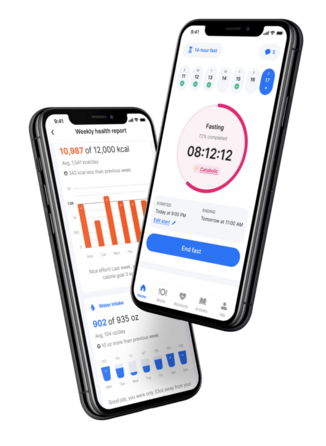Contents
What Is the Fasting-Mimicking Diet?
A fasting-mimicking diet, FMD, or a ProLon Fasting Mimicking Diet is a periodic diet created to mimic the physiological impact of fasting while still allowing you to consume some food.
This dietary pattern involves reducing your average caloric intake for a set period, typically a few days to a week. During this time, you may restrict your daily food intake to around 50-70% of your regular intake while still consuming essential nutrients and limiting certain foods, like carbohydrates or protein.
The fasting-mimicking diet might provide the same health benefits as fasting while allowing you to get all the necessary nutrients.
Fasting-mimicking diet vs. intermittent fasting
Intermittent fasting is a time-restricted eating pattern in which you cycle between periods of fasting and non-fasting. There are various types of fasting, including the 12:12, 14:10, 16:8, 18:6, 20:4 (the warrior diet), and alternate-day fasting, among others.
There are some critical differences between a fasting-mimicking diet and intermittent fasting:
- Structure — a fasting-mimicking diet is followed for a fixed period, while IF is a pattern of eating incorporated into a person’s lifestyle on an ongoing basis.
- Duration — IF can be followed for a more extended time and ultimately become a lifestyle.
- Nutrient intake — FMD provides certain nutrients in smaller quantities, whereas IF involves going without food for a specified period.
- Health benefits — IF includes more science-backed research confirming its benefits, such as reducing oxidative stress, increasing growth hormone production, improving insulin sensitivity, etc.
Both fasting-mimicking diets and intermittent fasting are effective for reducing weight and are used to improve health. However, many clinical trials have been done on IF and weight loss, while further studies are needed to determine the potential benefits of fasting-mimicking diets.
How Does the Fasting-Mimicking Diet Work?
As previously stated, the FMD is a low-calorie diet that involves consuming specific ratios of macronutrients (proteins, fats, and carbohydrates) that imitate the effects of fasting while still allowing you to consume a limited amount of calories.
The main goal of the FMD cycle is to promote weight loss, reduce total body fat, and boost your metabolic health.
But remember: you can follow this diet for up to 5 days only.
On the first day, you should consume approximately 1,100 calories while distributing your nutrient intake the following way:
- 11% protein, 46% fat, and 43% carbohydrates
During the remaining 4 days, you should stick with 725 calories per day while distributing your nutrients slightly differently:
- 9% protein, 44% fat, and 47% carbohydrates
What Can and Can’t You Eat on the Fasting-Mimicking Diet?
The fasting-mimicking diet often recommends getting a meal kit divided into five daily boxes. These foods are paired to trick your body into believing it is fasting while still providing energy.
The meal kit is plant-based, gluten-free, and lactose-free and is designed to provide an adequate protein intake and all necessary nutrients while still helping with weight loss. You may need three or more boxes to try out the diet.
If you decide to prepare the meals yourself, you’re allowed to eat foods like:
- Plant-based proteins — tofu, beans, lentils, etc.
- Non-starchy vegetables — leafy greens, cauliflower, tomatoes, peppers, broccoli, etc.
- Healthy fats — olive oil, coconut oil, avocado, etc.
- Nuts and seeds — pumpkin seeds, sunflower seeds, almonds, walnuts, etc.
- Legumes — chickpeas, beans, lentils, etc.
- Plant-based milk — soy milk, oat milk, almond milk, etc.
During the FMD, you should avoid the following:
- Animal protein — meat, fish, eggs, etc.
- Starchy vegetables — potatoes, corn, etc.
- Fruits — berries, bananas, oranges, etc.
- Processed foods — chips, cookies, sweets, etc.
- Dairy products — milk, yogurt, cheese, etc.
It is important to remember to stay within the calorie limit and pay attention to the recommended intake of protein, fats, and carbohydrates to achieve your health and weight loss goals.
You should also drink plenty of water or herbal teas to stay hydrated.
How Does the Fasting-Mimicking Diet Impact Weight Loss?
While effective for weight loss, fasting-mimicking diets are not traditional and may not be suitable for long-term weight reduction. However, as well as restrictive eating, this diet impacts weight loss and helps avoid obesity in the short run.
Research has shown that very low-calorie diets can lead to weight loss. According to a small study conducted by the creator of the diet, Dr. Longo, participants lost an average of 6 pounds and decreased waist circumference after completing three cycles of the fasting-mimicking diet over three months. The rate of safe weight loss is about 4 to 8 pounds a month, so the FMD can be considered a secure method to lose weight.
Yet, much more evidence is needed to prove that this diet is more effective at fat-burning than other diets or fasting methods. It is also not guaranteed that the weight lost will not be regained after returning to regular eating habits.
Luckily, this eating plan has other benefits apart from body weight reduction.
Other Health Benefits of the Fasting-Mimicking Diet
Intermittent fasting has several health benefits, including preventing chronic illnesses such as diabetes, heart disease, Alzheimer’s disease, and others. Let’s see whether a fasting-mimicking diet provides similar effects.
May help control blood sugar levels
A few human trials suggest that the fasting-mimicking diet may help control blood sugar levels and be beneficial for preventing diabetes. For instance, a research that examined 101 patients that followed the fasting-mimicking diet revealed a steady drop in blood sugar levels.
An animal study conducted on diabetic mice revealed that going on a diet every week for 60 days led to healthy insulin promotion and insulin resistance, which resulted in stable blood sugar levels.
The fasting-mimicking diet might be beneficial for managing blood sugar levels, yet more human research is needed to confirm these claims.
May support heart health by reducing cholesterol levels
High levels of LDL cholesterol (“bad” cholesterol) and low levels of HDL cholesterol (“good” cholesterol) can increase the risk of cardiovascular disease. Luckily, the fasting-mimicking diet may help regulate it.
A study by Dr. Longo found that participants who followed the fasting-mimicking diet significantly decreased cholesterol levels, with individuals who had high cholesterol levels experiencing a reduction of 20 mg/dl.
Take a
1-minute quiz
and discover how much weight you can lose with DoFasting!

May reduce inflammation and the risk of certain diseases
In addition to potentially regulating blood sugar and cholesterol levels, the fasting-mimicking diet may also have anti-inflammatory effects.
Inflammation is a normal immune response that helps heal injuries and fight infections, but chronic inflammation has been linked to various health conditions such as diabetes, cancer, and cardiovascular disease.
Intermittent fasting has been shown to have anti-inflammatory properties, so the fasting-mimicking diet may have a similar effect. An animal study on mice on FMD showed significantly lower levels of proinflammatory cells associated with autoimmune disease.
However, more research on humans is needed to make definite conclusions.
May support longevity
Fasting-mimicking diets have shown promising results for weight loss, improving insulin sensitivity, and reducing inflammation. These factors are associated with a lower risk of chronic diseases, a healthy lifespan, and healthy aging.
One study shows that a diet that mimics fasting influences multi-system regeneration and a healthy lifespan.
In addition, research has shown that a fasting-mimicking diet reduces brain pathology and improves cognitive performance, brain function, and mental clarity in Alzheimer’s. It may also stimulate the production of new neurons and improve cognition, which can be especially important in later life.
Risks and Downsides to Consider
Even though the diet has many promising health benefits, it also has some negative aspects you should be aware of.
May be too expensive for some people
One potential drawback of the FMD is its cost. To effectively follow this diet, you may need to purchase a meal kit, which can be expensive at around $249 per box. If you follow the five-day routine, the cost can quickly add up.
A cheaper alternative would be to try intermittent fasting—and you don’t need to jump right into long and difficult fasting windows! Start from the 12:12 routine and ease your way up from there.
IF is free if you decide to try it on your own. However, if you prefer to track your fasts and reach your results faster, an app such as DoFasting could be the best way to go. DoFasting helps you keep a close eye on what you’re eating, includes recipes and workouts to supplement your fasts, and offers a personalized fasting plan adapted to your individual needs.
May be difficult to follow
A fasting-mimicking diet requires a significant change in eating habits, which can lead to a lack of motivation, feelings of deprivation, and hunger. This diet also involves restricting calorie intake for a set time, which can be challenging for some people.
If you find it challenging to stick with this or any other eating habit, consider getting the support of a health coach.
Research still needed
Although some research indicates that periodic FMD has benefits like lower inflammation and longevity, more studies are needed on its effects on human health in the long term. The diet may not be suitable for everyone, and more information is necessary to determine which groups of people may benefit from it and which may not.
It is advisable to consult a registered dietitian before trying the fasting-mimicking diet.
Who Should Avoid the Fasting-Mimicking Diet?
Certain groups of people should avoid the FMD, including:
- Pregnant or breastfeeding women — the diet doesn’t provide enough nutrients necessary for the development and well-being of the baby.
- Children and teens — children and teens have specific nutritional requirements for growth and development that may not be met with this diet.
- People with certain health conditions — people with diabetes, kidney disease, or eating disorders also avoid the fasting-mimicking diet as it is unknown how it will affect them.
- People taking certain medications — the FMD might not be compatible with certain medications, so you should consult your doctor beforehand.
- People with low blood pressure — a fasting-mimicking diet might lower their blood pressure to a dangerous level, and they might need medical supervision.
Take a
1-minute quiz
and discover how much weight you can lose with DoFasting!

The Fasting-Mimicking Diet: Key Takeaways
A fasting-mimicking diet is a periodic diet designed to mimic the health benefits of fasting while allowing you to eat some food. It can help control your blood sugar, support your heart health, reduce inflammation, and support longevity.
However, it needs more scientific research and might be challenging to follow.
Before you try this approach, consult with your doctor to find the right diet for you.
See how DoFasting will improve your life
Find out what works for you with this 60-sec quiz approved by our experts and get your personal revolutionary fasting assistant.
Start the Quiz
This is an evidence-based article that includes scientific citations. DoFasting’s professional writers and editors prepared the content, which a team of medical experts verified to be accurate.














